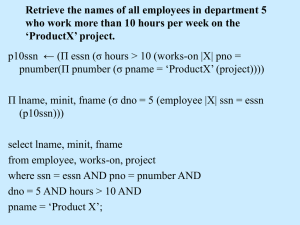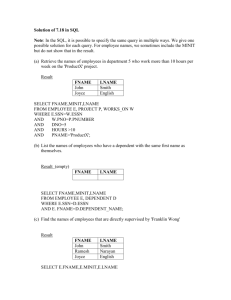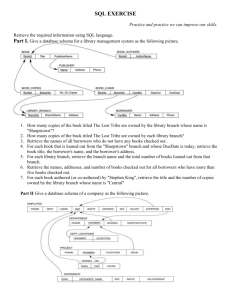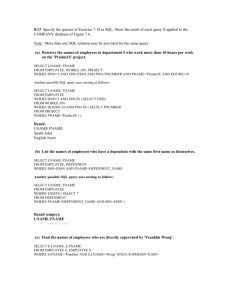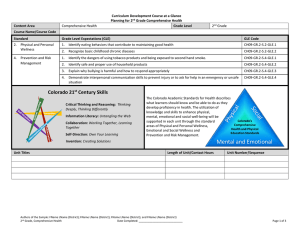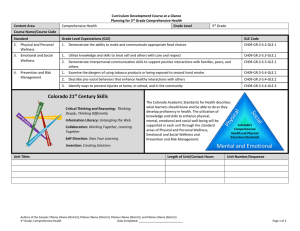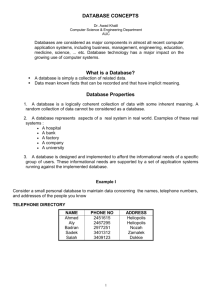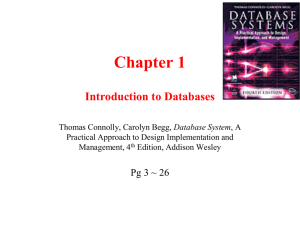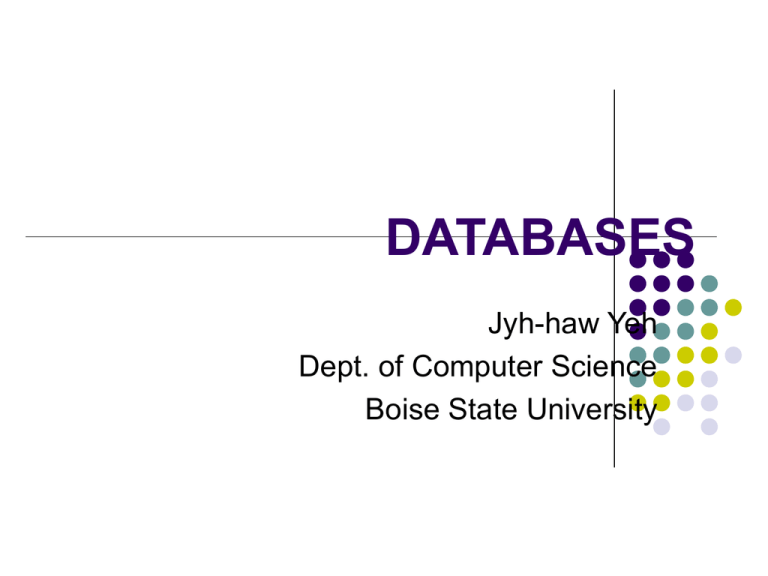
DATABASES
Jyh-haw Yeh
Dept. of Computer Science
Boise State University
What is a database?
A collection of related data, stored in a
structured way.
It represents some aspects of real world.
Databases are created and maintained by a
DBMS (DataBase Management System).
Well known DBMS: Oracle, Informix,
MySQL…
DataBase Management
Systems
DBMS facilitates the processes of defining,
constructing, and manipulating databases.
Defining a database: specify data type, structures
and constraints for the data.
Constructing a database: store data on some
storage medium.
Manipulating a database: querying and updating.
Database Design Process
Talk to clients to get the application’s
requirements and constraints.
Design the database using high level
conceptual data model, such as ER and
EER.
Use a mapping algorithm to convert ER or
EER to relational data model.
Database Design Process
(cont.)
Use the normal forms and functional
dependencies to fine tune the design.
Use some DBMS to create and maintain the
database.
Designing a Company Database
Client’s requirements and constraints:
The company is organized into DEPARTMENTS, each department has a unique
Name, a unique Number, and a particular EMPLOYEE as a MANAGER. We
keep track of the Start Date of the MANAGER. A department may have several
Locations.
A department CONTROLS some PROJECTS. A PROJECT has a unique
Name, a unique Number, and a single Location.
We store each employee's Name, Ssn, Address, Salary, Sex, and Birth Date.
An employee is ASSIGNED to one department but may WORK ON several
projects, which are not necessarily CONTROLLED by the same department. We
store the number of Hours per week that an employee works on each project.
Each employee has a direct SUPERVISOR.
We want to keep track of the DEPENDENTS of each employee for insurance
purposes. We keep each dependent's First Name, Sex, Birth Date, and
Relationship to the employee.
Designing a Company Database
Design the database by ER Model
Entity type: a type of real world entities.
Relationship type: relation between entities.
Attribute: describes the properties of entities.
Next page shows a possible design of the company database in
the ER model.
Designing a Company Database
Map ER model to relational model:
A mapping algorithm exists for the mapping.
A relational database is a set of tables (or
relations).
The table heading is a list of attributes.
Next page shows the result after mapping of the
company database in a relational model.
EMPLOYEE
FNAME
MINT
LNAME
SSN
BDATE
ADDRESS
SEX
SALARY
SUPERSSN
DEPARTMENT
DNAME
DNUMBER
MGRSSN
MGRSTARTDATE
DEPT_LOCATION
DNUMBER
DLOCATION
PROJECT
PNAME
PNUMBER
PLOCATION
PNO
HOURS
DNUM
WORKS_ON
ESSN
DEPENDENT
ESSN
DEPENDENT_NAME
SEX
BDATE
RELATIONSHIP
DNO
Designing a Company Database
Using functional dependency and normal
forms to fine-tune the database design.
The objectives of this step:
Clear semantics to attributes.
Reduce the NULL values.
Reduce data redundancy.
Avoid generate spurious tuples.
Examples: Figures 14.4, 14.5, 14.6
http://cs.boisestate.edu/~jhyeh/teach/cs410_bookfig
ures_ch14.pdf
Implement the Company
Database in a DBMS
Using SQL-DDL to create database:
The DDL for the company example is shown in
http://cs.boisestate.edu/~jhyeh/teach/cs410_bookf
igures_ch08.pdf
The company database will be created if a DBMS
executes the above DDL.
Next, using the load utility, provided by the DBMS,
to load data into the database.
http://cs.boisestate.edu/~jhyeh/teach/cs410_bookf
igures_ch07.pdf
Manipulating the Company
Database
Use SQL-DML to update or retrieve
information from the database.
Update, for example:
Insert a new employee, Delete a department,
Update someone’s salary….
Retrieve, for example:
Retrieve the names of employees who work
on multiple projects……
SQL-DML Examples
•
•
•
insert into EMPLOYEE
values (‘Richard’, ‘K’, ‘Jones’, ‘987654321’, ‘1972-08-25’,
‘101 University Dr., Boise, ID’, ‘M’, 55000, ‘888665555’,
1);
delete from DEPARTMENT
where DNAME = ‘Research’;
update EMPLOYEE
set SALARY = SALARY * 1.1
where DNO = 5;
SQL-DML Example
Query: retrieve the names
of employees who work on
multiple projects.
select FNAME, LNAME
from EMPLOYEE, WORKS_ON
where SSN = ESSN and
group by SSN
having count(*) > 1;
FNAME
LNAME
John
Smith
Joyce
English
Franklin
Wong
Alicia
Zelaya
Ahmad
Jabbar
SQL-DML Example
Query: retrieve the names
of employees in Research
department.
FNAME
LNAME
John
Smith
Franklin
Wong
Ramesh
Narayan
Joyce
English
select FNAME, LNAME
from EMPLOYEE, DEPARTMENT
where DNO = DNUMBER and
DNAME = ‘Research’;

